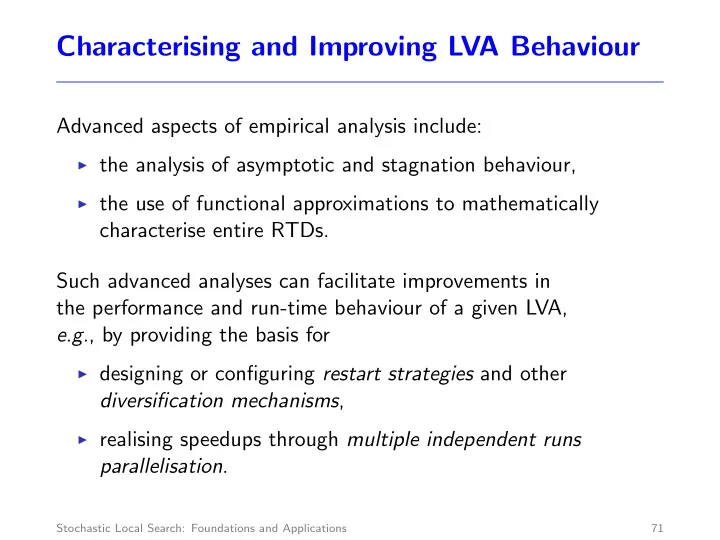

Characterising and Improving LVA Behaviour Advanced aspects of empirical analysis include: ◮ the analysis of asymptotic and stagnation behaviour, ◮ the use of functional approximations to mathematically characterise entire RTDs. Such advanced analyses can facilitate improvements in the performance and run-time behaviour of a given LVA, e.g. , by providing the basis for ◮ designing or configuring restart strategies and other diversification mechanisms , ◮ realising speedups through multiple independent runs parallelisation . Stochastic Local Search: Foundations and Applications 71
LVA efficiency and stagnation ◮ In practice, the rate of decrease in the failure probability , λ A ,π ( t ), is more relevant than true asymptotic behaviour. ◮ Note: Exponential RTDs are characterised by a constant rate of decrease in failure probability . ◮ A drop in λ A ,π ( t ) indicates stagnation of algorithm A ’s progress towards finding a solution of instance π . ◮ Stagnation can be detected by comparing the RTD against an exponential distribution. Stochastic Local Search: Foundations and Applications 74
Evidence of stagnation in an empirical RTD: 1 ed[18] 0.9 ILS 0.8 0.7 P(solve) 0.6 0.5 0.4 0.3 0.2 0.1 0 0.1 1 10 100 1 000 run-time [CPU sec] ‘ed[18]’ is the CDF of an exponential distribution with median 18; the arrows mark the point at which stagnation behaviour becomes apparent. Stochastic Local Search: Foundations and Applications 75
Approximation of an empirical RTD with an exponential distribution ed[ m ]( x ) := 1 − 2 − x / m : 1 empirical RLD 0.9 ed[61081.5] 0.8 0.7 P(solve) 0.6 0.5 0.4 0.3 0.2 0.1 0 10 2 10 3 10 5 10 5 10 6 run-time [search steps] The optimal fit exponential distribution obtained from the Marquardt-Levenberg algorithm passes the χ 2 goodness-of-fit test at α = 0 . 05. Stochastic Local Search: Foundations and Applications 80
Performance improvements based on static restarts (1) ◮ Detailed RTD analyses can often suggest ways of improving the performance of a given SLS algorithm. ◮ Static restarting , i.e. , periodic re-initialisation after all integer multiples of a given cutoff-time t ′ , is one of the simplest methods for overcoming stagnation behaviour. ◮ A static restart strategy is effective, i.e. , leads to increased solution probability for some run-time t ′′ , if the RTD of the given algorithm and problem instance is less steep than an exponential distribution crossing the RTD at some time t < t ′′ . Stochastic Local Search: Foundations and Applications 81
Performance improvements based on static restarts (2) ◮ To determine the optimal cutoff-time t opt for static restarts, consider the left-most exponential distribution that touches the given empirical RTD and choose t opt to be the smallest t value at which the two respective distribution curves meet. (For a formal derivation of t opt , see page 193 of SLS:FA.) ◮ Note: This method for determining optimal cutoff-times only works a posteriori , given an empirical RTD. ◮ Optimal cutoff-times for static restarting typically vary considerably between problem instances; for optimisation algorithms, they also depend on the desired solution quality. Stochastic Local Search: Foundations and Applications 83
Overcoming stagnation using dynamic restarts ◮ Dynamic restart strategies are based on the idea of re-initialising the search process only when needed, i.e. , when stagnation occurs. ◮ Simple dynamic restart strategy: Re-initialise search when the time interval since the last improvement of the incumbent candidate solution exceeds a given threshold θ . (Incumbent candidate solutions are not carried over restarts.) θ is typically measured in search steps and may be chosen depending on properties of the given problem instance, in particular, instance size. Stochastic Local Search: Foundations and Applications 84
Example: Effect of simple dynamic restart strategy 1 ILS + dynamic restart 0.9 ILS 0.8 0.7 P(solve) 0.6 0.5 0.4 0.3 0.2 0.1 0 0.1 1 10 100 1 000 run-time [CPU sec] Stochastic Local Search: Foundations and Applications 85
Other diversification strategies ◮ Restart strategies often suffer from the fact that search initialisation can be relatively time-consuming (setup time, time required for reaching promising regions of given search space). ◮ This problem can be avoided by using other diversification mechanisms for overcoming search stagnation, such as ◮ random walk extensions that render a given SLS algorithm provably PAC; ◮ adaptive modification of parameters controlling the amount of search diversification, such as temperature in SA or tabu tenure in TS. ◮ Effective techniques for overcoming search stagnation are crucial components of high-performance SLS methods. Stochastic Local Search: Foundations and Applications 86
Multiple independent runs parallelisation ◮ Any LVA A can be easily parallelised by performing multiple runs on the same problem instance π in parallel on p processors. ◮ The effectiveness of this approach depends on the RTD of A on π : Optimal parallelisation speedup of p is achieved for an exponential RTD. ◮ The RTDs of many high-performance SLS algorithms are well approximated by exponential distributions; however, deviations for short run-times (due to the effects of search initialisation) limit the maximal number of processors for which optimal speedup can be achieved in practice. Stochastic Local Search: Foundations and Applications 87
Speedup achieved by multiple independent runs parallelisation of a high-performance SLS algorithm for SAT: 100 bw_large.c (hard) 90 parallelisation speedup bw_large.b (easier) 80 70 60 50 40 30 20 10 10 20 30 40 50 60 70 80 90 100 number of processors Stochastic Local Search: Foundations and Applications 88
Recommend
More recommend